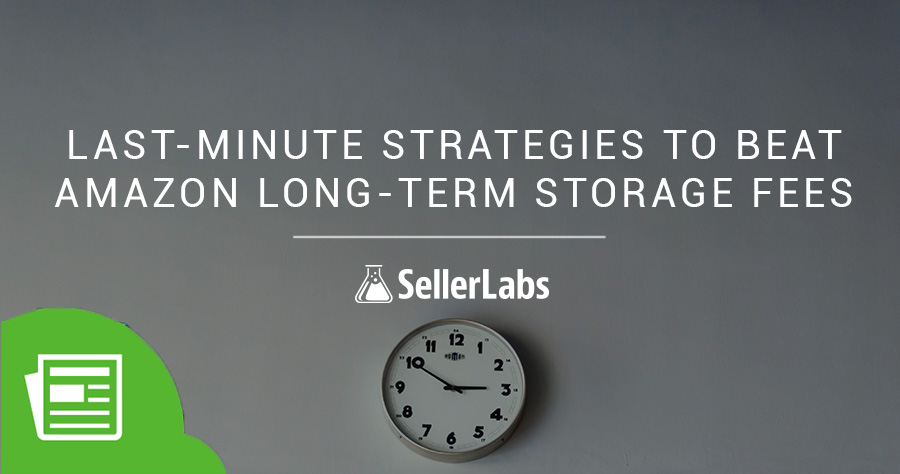With just less than a week until the big fulfillment center inventory clean out on August 15, the race is on to beat Amazon Long-Term Storage Fees. Here’s the scoop on LTSFs as well as tips for avoiding them (and yes, there’s still time for you to put a significant dent in your warehouse inventory and the cost of storing it).
What Are Amazon Long-Term Storage Fees and How Do They Work?
On February 15 and August 15 of every year, Amazon FBA cleans house, warehouse[s] that is. On these dates, inventory that has been in Amazon fulfillment centers for longer than six months is assessed one of two fees:
- For inventory that has been warehoused by Amazon for more than six months but fewer than 12 months, sellers are assessed a long-term storage fee of $11.25 per cubic foot of space used.
- For items that have been in fulfillment centers for 12 months or more, sellers are assessed a long-term storage fee of $22.50 per cubic foot of storage.
These semi-annual long-term storage fees are different from monthly storage fees and added to them. What does that mean for sellers? It’s incentive for you to turn your inventory quickly, preferably in less than six months, not only so you’re selling and earning but also so you are avoiding additional fees.
And honestly, even without Amazon’s long-term storage fee policy, that’s a good practice and one that will drive you to become more efficient all around in your inventory management. So treat the policy as an incentive rather than a punishment and get into the habit of really scrutinizing your reports and making adjustments to how much you order from your suppliers when you ship it to Amazon, and how you handle those times when you need to move more product more quickly.
Avoiding Amazon Long-Term Storage Fees
As alluded to above, the best way to avoid long-term storage fees is to—wait for it—not store stuff long term. That’s possible . . . to a point, and as a seller, one can always get leaner and meaner when it comes to inventory management. For our purposes right now and with regard to long-term storage fees, this really means vigilance in the forms of checking your reports and acting on information regularly and before it becomes a crunch time like the holidays or immediately before LTSFs kick in as they will on August 15. It also means actively working your inventory (not just replenishing or adding variations or new stock) and not being timid about pulling inventory back, ordering less (or none) from your suppliers, changing your prices, and running ads and promotions. More on that soon. For now (and because we all know that Seller Central is a cluttered place where resources can be frustrating to find and occasionally less than helpful), I want to share with you my favorite reports, tools, and help pages for monitoring inventory and staying steps ahead of my competitors and the calendar, and avoiding, or at least minimizing, the dreaded LTSF.
Resources for Assessing Inventory, Overstock Risks, and Potential Fees
Manage Excess Inventory Reports and Tools: If you’re cramming to avoid long-term storage fees, start here as it is the easiest, quickest, most-direct report: Its purposes are to:
- Explicitly show you which products are overstocked and by how many units
- Provide an estimated cost of doing nothing and leaving those products in Amazon storage
- Recommend what to do with those products (create a sale, create a removal order, advertise, improve keywords, edit a listing, or update product settings) and let you make changes from this page.
Don’t see anything in this report? Great. That means that according to Amazon, you’re not overloaded when it comes to any stock levels. However, you’re going to want to go at least one step further because while Manage Excess Inventory is no frills, it’s also not very intelligent or subtle.
FBA Inventory Age Reports and Tools: Within Manage Excess Inventory, a product either is or is not considered excess based on “the estimated number of units for which the cost of holding your inventory without taking any action is more than the cost of taking action (such as reducing prices to increase sales through or removing excess units). The default is quantity greater than 90 days of supply.” Cool enough. But what if you have a product that has been sitting for 89 days? You need to know about that.
The FBA Inventory Age report shows you the number of units in each age group (0-90 days, 91-180 days, 181-270 days, 271-365 days, 365+ days) that will be subject to long-term storage fees on the next charge date. It also shows the estimated LTSF charges for those units (assuming no further sales). You can also see recent sales performance for each SKU so you can factor in current trends as you decide what to do. Here, your options for each product include: advertising, editing the listing, improving keywords, lowering the price, creating a removal order, creating a sale, updating product settings, and creating a liquidation order).
Strategies for Selling Down Inventory in Order to Avoid (or Minimize) Long-Term Storage Fees
Even with less than a week before the August 15 fulfillment center cleanup when fees will be assessed, you still have options for drastically reducing stock levels. Hopefully, you’re already using some of these techniques to drive sales. Now let’s amp it up not just for the sake of increasing revenue but also for the sake of decreasing what you pay Amazon for storing your stuff.
Here are your last-minute options for avoiding/minimizing Amazon long-term storage fees (in order of my favorite to my least favorite):
1) Create a Sale: You can do this from the FBA Inventory Age report and Amazon will recommend a price point that should help you sell more (you can also just lower the price but Amazon gives no recommendation in that case). Set your sale run dates while you’re at it. Bonus beyond moving product out of Amazon’s warehouse: sell more now at a lower price, and satisfied customers will be back to buy more when the price is adjusted to reflect the sale no longer running.
2) Advertise:
- While it’s too late to sneak in a Lightning Deal, you can create a promotion with just four hours’ notice. In the case of trying to clear out inventory, free shipping or a discount can add appeal but you’d be wise to go with a Buy One, Get One promo. Amazon BOGOs are really flexible so you can be storage savvy and do things where if a shopper buys one small moderately expensive item, you can throw in two cheaper larger items and make a serious dent in your storage size.
- There’s barely time to try running a Sponsored Products ad campaign (better yet, try a free 30-day trial of Seller Labs’ Ignite software to add speed and accuracy to your campaigns), or, if you’re a brand owner who is registered in Amazon’s Brand 2.0, you can try running a Headline Search ad campaign. This sort of advertising doesn’t affect price point but it can put your products in the first position. Do note that Headline Search ads require approval, which of course takes time, and time is not on your side between now and the August 15 LTSFs. As well, Sponsored Products ads don’t guarantee you best placement (you have to win that) and better data is accrued over time, which again, is not your friend here. That all said, promotions are a better way to go at this late date.
3) Edit a Listing/Improve Keywords: This is all done in the same place and via the same method so I’m lumping them together. My recommendation here is that unless you are using software like Scope, a tool that shows you the very-best proven keywords as well as keywords being used by your competitors, now is not the time to go changing your product detail page and tempting the Amazon algorithm gods, fickle as they are.
4) Create a Removal/Create a Liquidation: First, check out your Recommended Removals to see what Amazon thinks about this (and take it with a grain of salt given that Amazon can profit from you authorizing removals). Understand that removing inventory from Amazon is not about helping you sell a product in the days before cleanup, it is about paying Amazon to get your inventory out of their warehouses before you get charged for keeping it there. If you opt to remove inventory, you must be okay with one or all of the following:
- Taking back potentially large costly shipments, processing them, and storing them a new
- Having perfectly good merchandise destroyed or otherwise disposed of (environmental consequences and all)
- Trusting that Amazon handles the removals as you have ordered and compensates you fairly should you be owed any monies from liquidation
As you may have gathered by me putting it last on the priority list of strategies for beating long-term storage fees and writing about it as I have, I’m not a fan of removing inventory if at all possible not to do so. There’s another reason that I don’t care for removing inventory if you can help it: If you set up a return-product removal order before August 15, 2017, you will be unable to send in additional units of those ASINs until January 1, 2018. That means that you miss holiday sales and you pay for the return and to ship the items back again. So, if you think your product has a decent chance of selling in Q4, you might want to just let it sit in the Amazon warehouse and take the hit on the LTSF until you can ramp up selling for the holiday season.
All of the caveats aside, sometimes you’ve just gotta get it gone. And if you hit that point, use the Recommended Removals Report and Tools. This report calculates, on an ASIN-by-ASIN basis, the quantity you would need to remove (assuming no further sales) to avoid long-term storage fees for that product (you can remove up to 150 products). Once identified, you can then create a removal order and request to have those units returned, disposed of, or liquidated—for fees of course (see below), so think hard about whether or not it might be better just to bite the bullet and keep your items where they are with Amazon. That decision is going to vary for each seller, and if you don’t want to have to make it on the fly, you can opt to remove inventory automatically.
| Service | Standard-size (per item) | Oversize (per item) | ||
| Return | Standard-size (per item) | $0.50 | Oversize (per item) | $0.60 |
| Disposal | Standard-size (per item) | $0.15 | Oversize (per item) | $0.30 |
| Liquidation | Standard-size (per item) | 10% of proceeds | Oversize (per item) | 10% of proceeds |
A note about removals: You must submit a separate removal order for each product. For each order, you have the option of having all units of all products in the request either returned or disposed of. If you want to have some units returned and others disposed of, you must again submit separate removal order requests. Kind of a drag to say the least.
My advice, as we head into the final days where it is still possible to minimize your long-term storage fees, is to bust your butt selling down as much as you can before using the nuclear option of paying Amazon to return, dispose of, and/or liquidate your merchandise. The good news about removals is that your inventory need not be physically out of the warehouse by the semi-annual cleanup date; you must only have submitted your removal requests before that date, so you really can use it as your last option.
Once you sort out this cleanup and you come out the other side of this semi-annual ordeal, give some serious thought to future shipments and when you send your inventory to Amazon. Understand the difference between your inventory sitting in Amazon fulfillment centers for six months and a day versus your inventory sitting there for five months and twenty-nine days. That difference could be a costly one and we’d like to help you avoid it.







